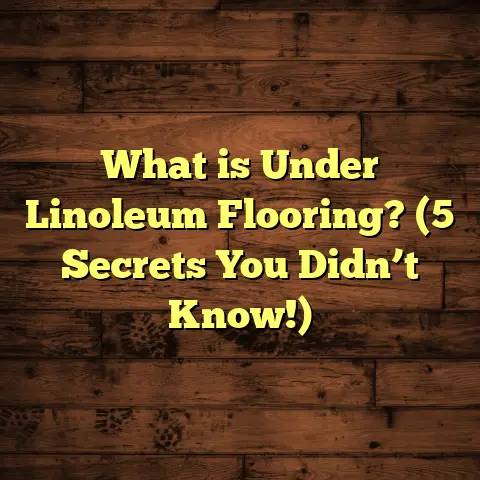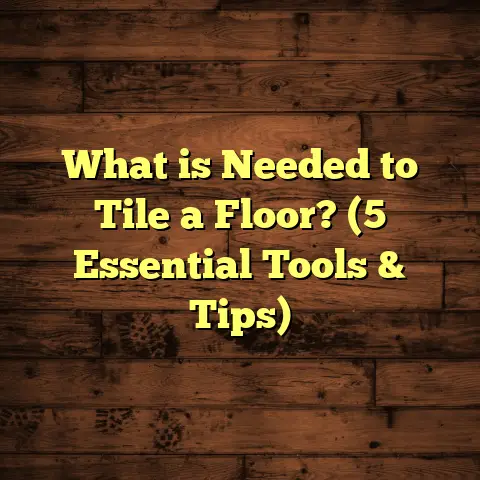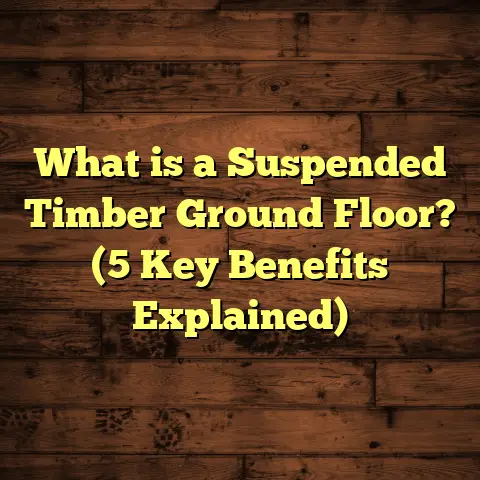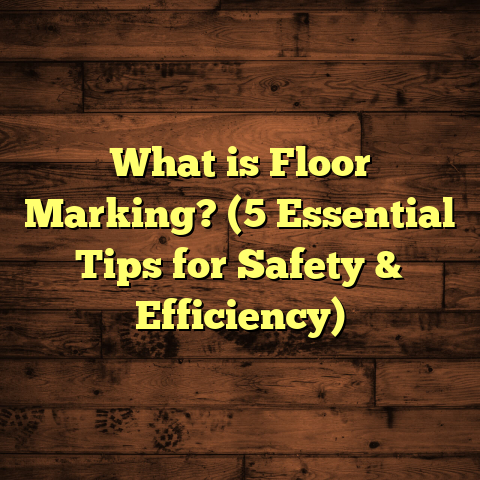What Is Homogeneous Vinyl Flooring? (5 Key Benefits Revealed!)
Aesthetic Appeal: Why I Fell for Homogeneous Vinyl Flooring
Have you ever walked into a room and immediately noticed how the floor ties everything together?
That seamless feeling of a well-chosen floor can transform a space from ordinary to something special.
When I first started working in flooring, I thought vinyl was just a cheap, temporary fix—something functional but not very stylish.
But homogeneous vinyl flooring changed that view entirely for me.
There’s something mesmerizing about its smooth surface and consistent color that makes it stand out.
It’s not flashy or over-the-top, but it has this clean, modern aesthetic that quietly elevates any room.
If you’ve been searching for a flooring option that balances looks, durability, and ease of maintenance, homogeneous vinyl might be exactly what you need.
Over the years, I’ve installed these floors in offices, schools, homes, and even hospitals.
Each project has taught me something new about why this material works so well and why it deserves more attention.
Let me share what I’ve learned about homogeneous vinyl flooring—how it’s made, why it performs so well, and the top benefits that have made me a fan.
What Is Homogeneous Vinyl Flooring?
Let’s start with the basics. What exactly is homogeneous vinyl flooring?
The term “homogeneous” means uniform or consistent throughout.
In flooring terms, homogeneous vinyl is made from one solid layer of vinyl material.
This means the color, composition, and pattern are the same all the way through the thickness of the sheet or tile.
Contrast this with heterogeneous vinyl flooring, which has multiple layers—a design layer on top supported by a backing layer underneath.
In heterogeneous vinyl, the top decorative surface can wear away over time and reveal a different color or texture beneath.
That doesn’t happen with homogeneous vinyl because the entire product is identical throughout.
This uniformity gives homogeneous vinyl some unique advantages:
- It’s extremely durable because there’s no weak top layer to peel or wear off.
- Scratches or surface damage don’t expose contrasting layers.
- The floor maintains a consistent look even as it ages.
- It resists heavy foot traffic and industrial use better than most vinyl types.
Homogeneous vinyl flooring usually comes in large sheets or tiles.
The sheets are often 6 to 8 feet wide and can cover large areas with minimal seams, which helps create that smooth look.
The material itself is a blend of polyvinyl chloride (PVC), plasticizers (which make it flexible), stabilizers (to protect from heat and UV), and pigments for color.
This mixture is heated and rolled into sheets in a process called calendaring. The sheets are then cut to size for installation.
My First Experience With Homogeneous Vinyl Flooring
I remember the first time I installed homogeneous vinyl flooring—it was in a small medical clinic.
They wanted a floor that could handle heavy daily cleaning with strong disinfectants but still look welcoming.
When we laid down the sheets, I was impressed by how smooth and sturdy the surface felt underfoot.
The clinic staff were happy because the floor didn’t trap dust or dirt like carpet did before. Plus, spills wiped up instantly without staining.
Fast forward three years: when I returned to check on the floor, it still looked great—no peeling edges or worn spots.
That was when I realized this wasn’t just another vinyl floor; this was something built to last.
That experience opened my eyes to how versatile homogeneous vinyl could be—not just in commercial spaces but homes too.
5 Key Benefits of Homogeneous Vinyl Flooring
1. Durability That Meets High-Demand Needs
Durability is probably the number one reason I recommend homogeneous vinyl flooring to many clients.
Because it’s one solid layer without separate coatings or decorative films, it handles wear and tear exceptionally well.
This makes it perfect for places with heavy foot traffic like hospitals, schools, airports, retail stores—and busy homes.
Some data to back this up: according to flooring industry reports, homogeneous vinyl can withstand up to 3 million foot traffic cycles before showing significant wear.
That’s a huge number compared to other resilient floors.
In one hospital project I worked on, we installed homogeneous vinyl throughout patient rooms and hallways.
Even after years of rolling beds, cleaning carts, and constant foot traffic, the floors showed minimal signs of wear.
You might ask: What about scratches or gouges? Because the color runs through the whole material, scratches don’t reveal a different color underneath.
Minor surface marks often blend in so well they go unnoticed.
2. Easy Maintenance Saves Time and Money Long-Term
I’ve seen many clients struggle with high-maintenance floors that need special care products or frequent repairs.
Homogeneous vinyl keeps things simple.
Its smooth surface means dirt and grime don’t get trapped easily. A quick sweep or mop with mild detergent usually keeps it looking fresh.
Unlike wood floors that require refinishing or carpets needing deep cleaning every few months, homogeneous vinyl only needs basic upkeep.
This lowers cleaning costs and reduces downtime in commercial buildings.
For instance, a school district I consulted for reported cutting their annual floor maintenance budget by 40% after switching to homogeneous vinyl in classrooms and hallways.
The floor’s resistance to stains also impressed me during a restaurant renovation project.
Spilled wine, grease, and sauces cleaned up quickly without leaving marks.
3. Consistent Aesthetic Appeal Over Time
One of the biggest frustrations with some flooring options is uneven fading or peeling patterns over time.
With homogeneous vinyl flooring, you don’t have that problem because the color and pattern run through completely.
This means:
- No discoloration from scratches or wear
- No peeling layers exposing ugly underlayers
- A consistent look even after years of use
In my experience working with designers, this consistency is a big selling point because it maintains the integrity of the space’s overall look without surprise damage spots.
Plus, many manufacturers offer solid colors or subtle patterns that fit minimalist or modern aesthetics well—perfect for offices or homes where you want a sleek look without loud designs.
4. Water Resistance That Protects Your Investment
Water damage is a common concern for many homeowners and businesses alike—especially in kitchens, bathrooms, or entryways.
Because homogeneous vinyl is made from synthetic materials that don’t absorb water, it offers excellent moisture resistance.
It won’t warp like wood or swell like laminate when exposed to water.
In fact, tests show homogeneous vinyl can resist standing water for hours without damage if sealed properly during installation.
I recall installing this flooring in a daycare center where kids constantly spilled drinks and tracked water inside during rainy days.
After two years of heavy use, there were no signs of swelling or water damage.
This makes it ideal not just for commercial spaces but also residential rooms prone to moisture like basements or laundry rooms.
5. Cost-Effective Solution That Doesn’t Feel Cheap
Cost is always a major factor in choosing flooring materials. Homogeneous vinyl strikes a good balance between price and performance.
Based on supplier quotes I’ve gathered across different regions over several years:
- Material costs range from about $2 to $5 per square foot
- Installation adds roughly $1.50 to $3 per square foot depending on complexity
- Maintenance costs remain low due to easy cleaning
Compare this with hardwood floors costing $8+ per square foot installed or luxury vinyl planks priced similarly but sometimes less durable in high traffic areas.
This affordability makes homogeneous vinyl attractive for large commercial projects where budgets are tight but quality can’t be compromised.
Diving Deeper: How Homogeneous Vinyl Flooring Is Made
Understanding how homogeneous vinyl is manufactured helps explain its unique properties.
The process starts with mixing PVC resin with plasticizers—these make the final product flexible rather than brittle.
Next, stabilizers are added to protect against heat degradation and UV exposure which can cause fading or cracking over time.
Pigments provide color uniformly distributed throughout the mixture ensuring consistent appearance in every part of the sheet.
This blend is heated until molten and then passed through rollers in a process called calendaring which forms very thin sheets with uniform thickness.
Because these sheets are one continuous material (no separate layers), they avoid failures common in multi-layered products like delamination or surface peeling.
Once cooled and cured, they’re cut into rolls or tiles ready for shipping and installation.
Installation Insights: What You Should Know From My Experience
Installing homogeneous vinyl flooring requires some special attention but isn’t overly complicated if done right.
Here are some practical tips from my projects:
- Subfloor preparation is key: The surface must be clean, dry, flat, and free of debris before laying down the sheets. Uneven subfloors can cause bubbles or early wear.
- Use recommended adhesives: Strong glue designed for vinyl should be evenly applied for full adhesion.
- Allow room for expansion: Like most resilient floors, leave small gaps at edges to allow for natural expansion and contraction.
- Seam welding: For sheet installations especially in commercial settings, heat welding seams creates water-tight joints preventing moisture penetration.
- Professional installation recommended: While DIY is possible for small areas using tiles or planks, large sheet installations benefit from experienced crews to avoid wrinkles or misalignment issues.
From my perspective working on large healthcare and educational facilities where hygiene standards are strict, seamless installations not only improve durability but also make cleaning easier by eliminating dirt traps along edges.
Comparing Homogeneous Vinyl With Other Flooring Options
If you’re considering homogeneous vinyl, you might be wondering how it stacks up against alternatives like:
| Flooring Type | Durability | Water Resistance | Maintenance | Cost (Material + Installation) | Aesthetic Flexibility |
|---|---|---|---|---|---|
| Homogeneous Vinyl | Very High | Excellent | Low | $3.50 – $8 per sq.ft | Moderate |
| Hardwood | Moderate-High | Poor | High | $8 – $15 per sq.ft | Very High |
| Laminate | Moderate | Poor | Moderate | $4 – $7 per sq.ft | High |
| Heterogeneous Vinyl | Moderate | Good | Low | $3 – $7 per sq.ft | Very High |
| Carpet | Low | Poor | High | $3 – $8 per sq.ft | High |
| Ceramic Tile | Very High | Excellent | Moderate | $6 – $12 per sq.ft | High |
Looking at durability alone, homogeneous vinyl consistently ranks near the top due to its single-layer construction.
Its water resistance also outperforms hardwood or laminate by far.
While aesthetic flexibility isn’t as broad as heterogeneous vinyl (which can mimic wood grains or stone), its consistent solid look fits modern design trends well.
Maintenance-wise it beats carpets (which trap allergens) and hardwood (which needs refinishing).
Environmental Impact: What You Should Know
One question I get often is about how eco-friendly vinyl flooring really is since it’s made of PVC plastics.
Here’s what I found after researching:
- PVC production involves fossil fuels and releases greenhouse gases.
- However, many manufacturers now produce recycled-content options reducing virgin material use.
- Some brands offer take-back programs to recycle old flooring instead of landfill disposal.
- The long lifespan of homogeneous vinyl means fewer replacements over time lowering waste output.
- Its ability to be cleaned without harsh chemicals also contributes positively compared to some other floors needing toxic cleaners.
I personally advise clients who prioritize green building certifications (like LEED) to check product specs carefully but not discount homogeneous vinyl outright—especially if durability reduces replacement frequency significantly.
More Stories From The Field
How Homogeneous Vinyl Saved a Busy Retail Store Floor
A local retailer faced ongoing problems with their previous laminate floor peeling around entrances where rainwater seeped in regularly.
We installed homogeneous vinyl sheets glued down tightly with heat-welded seams at all joints creating a water-resistant surface.
After one year of heavy foot traffic and wet weather seasons, their floor still looked impeccable without any bubbling or edge lifting reported.
The store manager said switching saved them money on repairs and gave customers a better first impression walking in every day.
A Homeowner’s Surprise After Choosing Homogeneous Vinyl
One family I worked with initially wanted hardwood throughout their kitchen/dining area but were concerned about water spills from cooking and kids running around with drinks.
We proposed homogeneous vinyl as an alternative offering similar clean lines but better resistance to moisture and scratches at half the price.
After installation, they told me they were thrilled with how easy cleaning was after parties and how comfortable it felt underfoot compared to tile options they considered before.
Understanding Warranties and Lifespan
Most reputable manufacturers back homogeneous vinyl flooring with warranties ranging from 10 to 20 years depending on product grade and installation quality.
It’s worth asking about:
- Wear layer thickness (usually 20 mils or more indicates longer life)
- Resistance against stains/fading
- Installation coverage (does improper installation void warranty?)
With proper care including regular cleaning and avoiding sharp objects dragging across the floor surface, these warranties aren’t just marketing—they reflect real durability potential based on lab tests and field data.
Can You Install Homogeneous Vinyl Flooring Yourself?
If you’re handy around the house and considering DIY installation for small areas using tiles or planks made from homogeneous vinyl material:
- Make sure your subfloor prep is thorough.
- Use correct adhesives recommended by manufacturer.
- Follow instructions precisely for cutting and fitting pieces.
- Have proper tools like roller for pressing adhesive evenly.
- Take your time lining up seams perfectly—mistakes here are hard to fix later.
For large sheet installations especially commercial jobs requiring seam welding or complex layouts I always recommend professional installers due to skill needed for flawless results that last decades.
Final Reflections on Homogeneous Vinyl Flooring
After installing numerous floors over many years—from corporate offices to cozy homes—I keep coming back to homogeneous vinyl as one of my favorite resilient options available today.
It offers a rare combination: low maintenance paired with serious durability plus an understated aesthetic that fits many styles without screaming “vinyl.”
If you want your floors to hold up against daily abuse while staying easy on your budget and eyes alike, give this type of flooring serious thought.
Have questions? Thinking about trying it? Reach out anytime—I’m happy to share more stories from my work that might help you decide if this could be your next floor!





